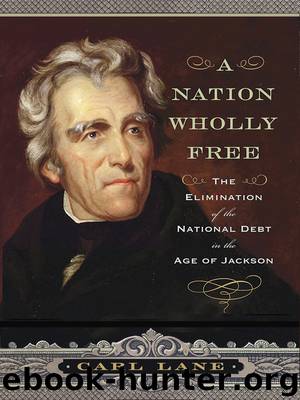A Nation Wholly Free by Carl Lane

Author:Carl Lane
Language: eng
Format: epub
ISBN: 9781594165870
Publisher: Westholme Publishing
Resolution of the crisis under Clay's formula raises a question first addressed by James Parton, Jackson's nineteenth-century biographer. Why did South Carolina abandon the Verplanck bill? After all, it promised the same sharp rate reductions in two years which Clay's bill provided in ten. “The nullifiers in Congress,” Parton wrote, “could have carried the Verplanck bill if they had given it a frank and energetic support.”45 They did not, but why not? Parton attributed Clay-Calhoun cooperation to their shared enmity for President Jackson, the complex politics surrounding appointments to the select Senate committee created to consider the Clay plan, Jackson's attempts to influence those appointments, and the pressures on Calhoun to settle the tariff issue.46 Since Parton, historians have largely ignored this matter.
Politics, of course, were involved, but the status of the national debt factored into those politics. Clay's behavior is relatively easy to understand. Having lost the 1832 presidential election, he no longer had reason to delay or oppose timely debt payment. At the same time he had little to gain from the Verplanck bill because it would hurt manufacturers whom he wanted to protect. Coming up with a different formula that Calhoun could accept would enhance his reputation as a compromiser, seemingly save the union, and perhaps prepare the way for a future presidential bid.
Calhoun's behavior is less transparent. The Verplanck bill gave to South Carolina most of what it demanded. Yet it is important to remember that in 1816 South Carolina had accepted protectionism because increased federal revenues allowed a rapid pay-down of the national debt. Monroe's 1824 announcement that the debt would be paid off at the end of 1834 meant that serious downward revision of the tariff was warranted. The modest reductions included in the 1832 tariff disappointed Calhoun and the South Carolina leadership: Hence the Ordinance of Nullification, threatening the revenue system and the timely extinction of the debt on January 1, 1835, in order to pressure the government into more substantive tariff relief. From this perspective South Carolina's defiance of federal policy exposes a contradiction. The state held debt freedom hostage at the same time that it demanded, or said it demanded, free trade, which, however, depended upon securing debt freedom.
South Carolina's abandonment of the Verplanck bill in favor of the Clay compromise suggests an answer to this problem. South Carolina was engaging in a common ploy: Demand everything, but settle for less. But the Verplanck bill, as it turned out, by yielding to so much of South Carolina's demand, actually went further than South Carolina really wanted to go. Why? Because embedded in the Verplanck bill was the possibility—the risk—that after 1835 the government would face revenue shortfalls that would require either raising the tariff again or contracting new debt. Neither alternative was in South Carolina's long-term interest. Accordingly, the gradual reduction of the tariff over a decade was more likely to achieve the state's ultimate objective: free trade. Calhoun was an intelligent man and likely understood this. On March 1, 1833,
Download
This site does not store any files on its server. We only index and link to content provided by other sites. Please contact the content providers to delete copyright contents if any and email us, we'll remove relevant links or contents immediately.
International Integration of the Brazilian Economy by Elias C. Grivoyannis(74969)
The Radium Girls by Kate Moore(11621)
Turbulence by E. J. Noyes(7702)
Nudge - Improving Decisions about Health, Wealth, and Happiness by Thaler Sunstein(7244)
The Black Swan by Nassim Nicholas Taleb(6770)
Rich Dad Poor Dad by Robert T. Kiyosaki(6179)
Pioneering Portfolio Management by David F. Swensen(6081)
Man-made Catastrophes and Risk Information Concealment by Dmitry Chernov & Didier Sornette(5650)
Zero to One by Peter Thiel(5494)
Secrecy World by Jake Bernstein(4389)
Millionaire: The Philanderer, Gambler, and Duelist Who Invented Modern Finance by Janet Gleeson(4099)
The Age of Surveillance Capitalism by Shoshana Zuboff(3989)
Skin in the Game by Nassim Nicholas Taleb(3968)
The Money Culture by Michael Lewis(3849)
Bullshit Jobs by David Graeber(3831)
Skin in the Game: Hidden Asymmetries in Daily Life by Nassim Nicholas Taleb(3724)
The Dhandho Investor by Mohnish Pabrai(3561)
The Wisdom of Finance by Mihir Desai(3526)
Blockchain Basics by Daniel Drescher(3330)
